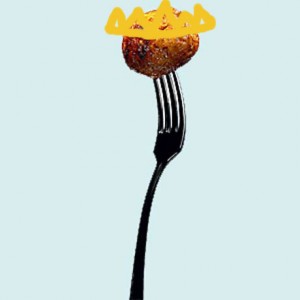Every day I try to get gum from the vending machine. I get other things sometime: seltzer (E4), or dried asian pear (D3) (shut up), but the gum I try for daily. Why do I say try? Because the goddamn motherfucking gum never drops down into the place where you stick your hand to get it. YET I KEEP TRYING. I know, Freud, insanity, etc. BUT LOOK! You can see that the gum packets on either side of the Doublemint are still behind the gate, but the Doublemint is in front of the gate yet still behind the plexiglass. AN INJUSTICE.
Snacktime
Asked and Answered
Deep thoughts at Jezebel!
Q:
Any discussion of a Food Network personality – be it Sandra’s tablescapes to Guy Fieri’s antics to Ina’s luxurious lifestyle (and I’m not even getting into Rachael Ray) – brings forth a similar barrage of passionate mixed feelings. What is it about food personalities that gets us so riled?
A:
The ambivalence towards current food celebrities, of course, is not that different from that we see leveled at any celeb: the scrutiny of appearance and private life is as cruel and irrational as that applied to all entertainers. But there’s something more, and I wonder if it doesn’t have to do with the fact that, well, we all eat.
It’s not that different, but there is something more, and it’s because we eat.
Meatball Will Outlive Us All
Have we mentioned that it’s been 1,000 degrees in New York for approximately a year? When we are all dead of heat exhaustion (I will probably succumb today), Meatball will carry the torch, according to this Time magazine story that has already been linked everywhere.
Once Again, We Encourage a Commenter to Think About the Man in the Mirror
Balls Out

You guys, last night I was totally craving testicle pizza and testicles in bechamel sauce flavored with a variety of herbs and I couldn’t find it anywhere. I know I say this all the time, but I should have been in Serbia. There, in Belgrade, the World Testicle Cooking Championship just took place! People, it is not just about eating kangaroo testicles. It is about bravery, according to the organizer. They even give out an award for being “ballsy.” This year the winners were President Obama (somebody tell Maureen Dowd!) and Sully Sullenberger, the pilot who landed in the Hudson back in Jan 09. Strangely, neither was present to accept his award.
The Whole Lie
Whole Foods CEO John Mackey, in USA Today:
On like items, Whole Foods is very competitive. … We have 30,000 items, and you can probably find 30 on which we’re more expensive. Look at our 365 private-label line, which we price against Trader Joe’s. We match their prices. But you can’t always be cheapest if you have the highest quality.
This is what people are always saying about Whole Foods. “On a lot of things it’s so much cheaper!” Well, yes, their prices on organic peach granola might be cheaper than organic peach granola is at your corner store that isn’t making big orders because they need to have a variety of price points on their shelves. But if all you can afford (or want!) is Cheerios or something, that “cheaper at Whole Foods” thing is kind of a joke.
Shut Up Bacon, We’ve Lost Count: Cookie Monstrosity
Eat, Pray, Sell Gourmet

Substitute “Portland,” “Seattle,” or multiple other cities in the graf below:
Carrot buns, lemon macaroons, golden veal cutlets and tamarind ice cream spiked with balsamic vinegar are taking New York by storm, as street carts trade working-class fare for delicacies.
One thing that really irks me about the food truck thing is that it’s only become a “trend” now that food trucks are “gourmet” and run by middle class people. I grew up in Los Angeles going to taco trucks all the damn time, and since living in New York have eaten multiple falafels, pretzels, and ice cream sandwiches from food trucks.
And it’s even more irksome when you read about people like Oleg Voss, “a 28-year-old culinary school graduate and one-time investment banker.” He had to give up his lucrative job in Vienna to open his veal cutlet cart, because of “the brutal economic recession.” That is brutal!
It seems like “I opened a niche gourmet food business” is the new “I found myself.” Who needs an ashram when you can sell artisanal delicacies to people who enjoy the added flavor of self-righteous foodiness? Oh and isn’t it funny, hahaha, when people who have been working on the street for their entire lives don’t take kindly to being pushed out of business by a trend? Take, for example, two former marketing executives who have now opened a gourmet ice cream truck:
“Three Mister Softee guys came and threatened to burn our truck,” said Di Mille, referring to the half-century old franchisor of trucks serving up soft ice cream.
Yeah I don’t know why they would have an issue with two former marketing executives with “friends in the New York police force” taking away their business. After half a century.
Birthday Science
A fascinating piece by Kathryn McGowan about the industrial changes that gave rise (HAR) to the modern birthday cake.
Before the invention of roller mills (about 1870) flour was made using grind stones resulting in flour that contained some of the bran and all of the germ of the wheat. To get white flour the miller then had to sift or boult the flour through a succession of cloths of differing weaves which filtered out the bran and the germ. The oil that comes out of the germ during milling stayed in the flour giving it a gray-ish yellow color. The presence of that oil shortened the shelf-life of white flour to about six months after which it would go rancid. All of these limitations meant that white flour was expensive and used only by the wealthy or for special occasions.
When flour is ground using rollers, the grain passes through two rollers moving at different speeds the slower one holds it and the faster one strips it. Scraping off the germ before grinding meant that no germ or germ oil got into the flour. And so was created the first truly white flour, ground solely from the endosperm of the wheat. It was a snowy white and due to the lack of wheat germ and wheat germ oil, it had double the shelf life of the old style “white” flour. The new technology made it much less expensive and the longer shelf-life meant that it could be shipped all over the country. Everyone could have white flour.
The other invention important to those towering, sugar-laden birthday treats is baking powder. It was Initially created in England in 1843. The first American manufacturers were Evan Norton Horsford and George F. Wilson who founded the Rumford Chemical Works in Providence, Rhode Island in 1857. Before chemical leavening, cakes had to be raised with the power of eggs alone, which requires a lot of elbow grease with a whisk (remember, no stand mixers in the 19th Century), and speed to get it into the oven before it begins to collapse. It took an expert baker with lots of skill to make a fluffy, high angel food cake. Baking powder changes all of this, anyone could just add some to their recipe and poof, a cake as light as a cloud.
She also makes a “birthday cakes” recipe from 1870 and goes on a search for candied caraway seeds. I could have done with more SCIENCE! and less BAKING, but still.
Going to the Dark Side

You'll never know just how I feel.
Yesterday I did a shocking thing. I took a picture of my food. I know! We think that’s funny! But something compelled me….



